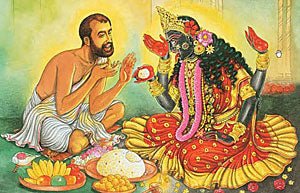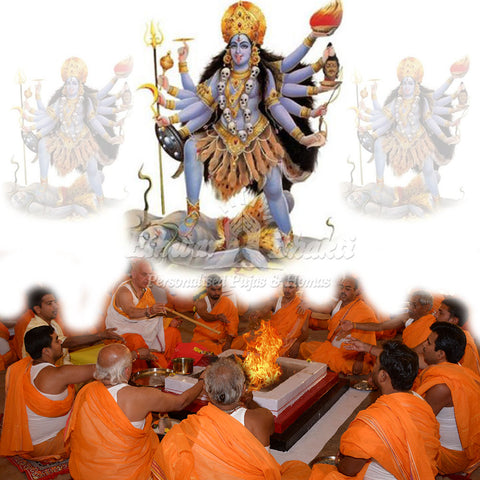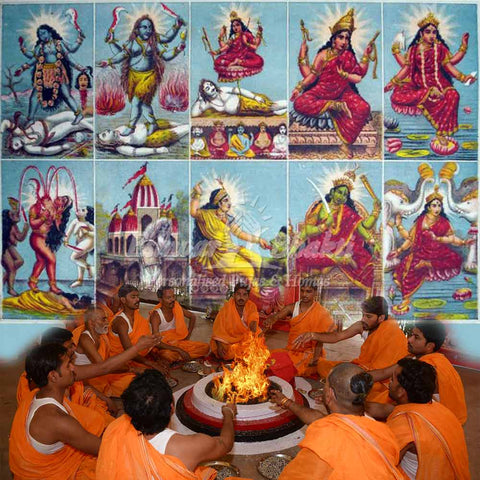Goddess Kali
 Although the name of kali has lately been associated with Kala(black), most scholars agree that the name is actually derived from Kala which means time or death. Kali is said to give her devotees freedom from the fear of death and liberation from the cycle of time.
Although the name of kali has lately been associated with Kala(black), most scholars agree that the name is actually derived from Kala which means time or death. Kali is said to give her devotees freedom from the fear of death and liberation from the cycle of time.
The origin of kali isn't exactly clear. It is said that she first finds mention in the Atharva Veda. However, the Veda doesn't recognise her as a Goddess. Later, She is mentioned elaborately in various Puranas. Kali finds her most remarkable mention in the Devi Mahatmya in which there are several chapters dedicated to her. This text gives a detailed explanation of Kali and depicts many stories related to her.
Symbolism: Kali has been illustrated in many forms and figures in different cultures and depictions. However, the most popular form of kali is that of a dark blue-skinned goddess with four hands, a garland of skulls, with tongue out of her mouth. Her eyes are red and filled with rage. She is holding a crescent-shaped sword in one hand and a trident in the other.
In the other two hands, she is holding a human skull and a bowl to collect dripping blood. While the sword signifies divine knowledge, the skull represents the severed ego. She is in extreme rage and in a mood to destroy anything and everything which comes in her way.
In many iconographies, Kali is depicted with one of her feet on Her consort Shiva. There is a very interesting story behind the same. It is said that once Kali was in a very destructive form and after slaying demons, her rage knew no bounds. She was ready to destroy everything. Seeing that Kali wouldn't stop by any other means, Shiva just lied down on her way. Kali stepped on Shiva and realizing that she stepped on her consort, she finally calmed down. It is said that because of the embarrassment faced by kali, the tongue came out of Her mouth.
There is also a story behind why Kali holds a bowl of blood in her hands. There was an demon named Raktabija who was causing havoc to demi-gods. No one could defeat him. The moment a drop of blood from his body fell on the ground, a clone would appear. This made it impossible to kill him. At last, Kali in her ferocious form slayed the demon and collected every drop of blood in the bowl She holds. In this way, finally, Raktabija was killed. Thus, Kali is shown holding a bowl of blood in her hands.
Different forms of Kali: Kali has manifested and worshipped in many forms. Initially, Kali was chiefly associated with tantra. Cremation ground was Her main worship place. She has been discussed vividly in many tantric texts. Some sects even symbolise Her as the Para Brahman or the supreme truth. She is also one of 10 Mahavidyas worshipped in the tantric texts.
However, over time, She became a household goddess. Even those living a family life started worshipping Her. She is seen as a mother and protector. There are many different forms in which Kali is worshipped today.
● Mahakali: Mahakali means the greatest Kali. She is usually depicted having ten heads, ten arms, and ten legs. The prefix 'maha' glorifies Kali and positions her as the ultimate reality, the brahman. In this form, She is shown as the source of all that exists. She is even the source of the power of the devas and the one who grants liberation.
● Samhara Kali: She is the presiding goddess of chief tantric texts. Samhara Kali is mainly worshipped by tantriks. She is the most dangerous and ferocious form of Kali. She symbolizes the power of destruction. She is also the one who grants death and liberation. Samhara kali is usually depicted with Her left foot forward and sword in her right hand.
● Dakshina Kali: She is the most benevolent and loving form of goddess Kali. This form of Kali is mainly worshipped by the householders. She is the one who gives blessings and boons to her devotees. This is generally the most popular form of Kali which is worshipped by many. It is said that even Yama, the god of death fears Her name.
● There are many other forms of Hali that are worshipped by different sects. This includes Guhya kali, Bhadra Kali, Raksha Kali, Kamakala Kali, and many others.
 Kali and Ramakrishna: Any talk on Kali will never be complete without mentioning the great saint, Sri Ramakrishna Paramhansa, also the Guru of Swami Vivekananda. He was the priest of Dakshineswar temple, along the banks of Ganges in Kolkata.
Kali and Ramakrishna: Any talk on Kali will never be complete without mentioning the great saint, Sri Ramakrishna Paramhansa, also the Guru of Swami Vivekananda. He was the priest of Dakshineswar temple, along the banks of Ganges in Kolkata.
His devotion to Kali had no parallels. It is said that he would dance, sing, and go berserk just to have a glimpse of mother Kali. He would not eat for days in the anticipation that mother Herself would come and feed him. There are many events in his life that are beyond logic. He had a great influence on the Bhakti movement and many prominent personalities of that time. Ramakrishna became immortal in the heart of devotees through his own power of devotion and the ultimate surrender to the mother of all.
Festival: The grand festival related to the goddess Kali is known as Kali puja. Although it is celebrated in many parts of India, this festival can be observed in its grandeur primarily in Bengal. It is celebrated during the same time as Diwali and the Devi is worshipped in her full glory.
Summary: Kali is not one of the usual goddesses in Hinduism. She was mainly the goddess of tantrics and worshipped in the cremation ground. However, with time, even householders started worshiping her. And now, she is one of the most worshipped goddesses, especially in west Bengal. Although her depiction is that of a ferocious and fearsome goddess, many find a motherly affection in her persona and worship her as their protector. Above all, Kali takes away the fear of death and blesses one with liberation, the ultimate goal of human life, the ultimate freedom from all sufferings, beyond which nothing exists.


